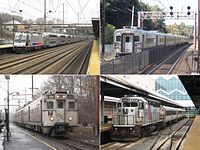
The Port Authority Trans-Hudson (PATH) is a 13.8-mile (22.2 km) rapid transit system in the northeastern New Jersey cities of Newark, Harrison, Jersey City, and Hoboken, as well as Lower and Midtown Manhattan in New York City. It is operated as a wholly owned subsidiary of the Port Authority of New York and New Jersey. PATH trains run around the clock year-round; four routes serving 13 stations operate during the daytime on weekdays, while two routes operate during weekends, late nights, and holidays. It crosses the Hudson River through cast iron tunnels that rest on the river bottom. It operates as a deep-level subway in Manhattan and the Jersey City/Hoboken riverfront; from Grove Street in Jersey City to Newark, trains run in open cuts, at grade level, and on elevated track. In 2023, the system saw 55,109,100 rides, or about 187,000 per weekday in the fourth quarter of 2023.

New Jersey Transit Corporation, branded as NJ Transit or NJTransit and often shortened to NJT, is a state-owned public transportation system that serves the U.S. state of New Jersey and portions of the states of New York and Pennsylvania. It operates bus, light rail, and commuter rail services throughout the state, connecting to major commercial and employment centers both within the state and in its two adjacent major cities, New York City and Philadelphia. In 2023, the system had a ridership of 209,259,800.

The PATCO Speedline, signed in Philadelphia as the Lindenwold Line and also known colloquially as the PATCO High Speed Line, is a rapid transit route operated by the Port Authority Transit Corporation (PATCO), which runs between Philadelphia, Pennsylvania, and Camden County, New Jersey.
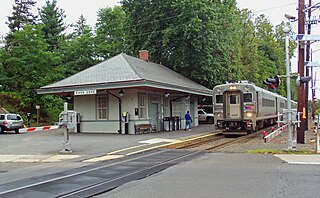
The Pascack Valley Line is a commuter rail line operated by the Hoboken Division of New Jersey Transit, in the U.S. states of New Jersey and New York. The line runs north from Hoboken Terminal, through Hudson and Bergen counties in New Jersey, and into Rockland County, New York, terminating at Spring Valley. Service within New York is operated under contract with Metro-North Railroad. The line is named for the Pascack Valley region that it passes through in northern Bergen County. The line parallels the Pascack Brook for some distance. The line is colored purple on system maps, and its symbol is a pine tree.
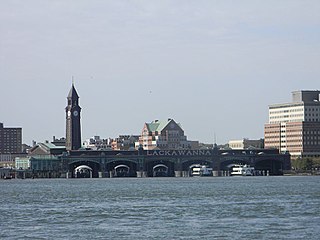
Hoboken Terminal is a commuter-oriented intermodal passenger station in Hoboken, Hudson County, New Jersey. One of the New York metropolitan area's major transportation hubs, it is served by eight NJ Transit (NJT) commuter rail lines, an NJ Transit event shuttle to Meadowlands Sports Complex, one Metro-North Railroad line, various NJT buses and private bus lines, the Hudson–Bergen Light Rail, the Port Authority Trans Hudson (PATH) rapid transit system, and NY Waterway-operated ferries.
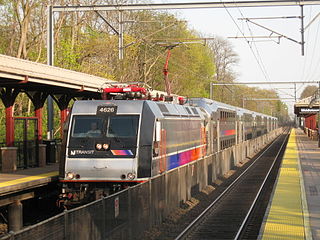
The North Jersey Coast Line is a commuter rail line running from Rahway to Bay Head, New Jersey, traversing through the Jersey Shore region. Operated by New Jersey Transit, the line is electrified as far south as Long Branch. On rail system maps it is colored light blue, and its symbol is a sailboat. The line runs along the former New York & Long Branch Railroad, which was co-owned by the Central Railroad of New Jersey and the Pennsylvania Railroad.

A trapdoor is a sliding or hinged door that is flush with the surface of a floor, ceiling, or roof. It is traditionally small in size. It was invented to facilitate the hoisting of grain up through mills, however, its list of uses has grown over time. The trapdoor has played a pivotal function in the operation of the gallows, cargo ships, trains, booby traps, and more recently theatre and films.

The BiLevel Coach is a bilevel passenger railcar currently built by Alstom and previously by Bombardier, Hawker Siddeley Canada, the Canadian Car and Foundry, and the UTDC. Used by North American commuter rail operators, they hold 360 passengers and feature a distinctive octagonal profile.

The Atlantic City Line (ACL) is a commuter rail line operated by NJ Transit (NJT) in the United States between Philadelphia, Pennsylvania and Atlantic City, New Jersey, operating along the corridor of the White Horse Pike. It runs over trackage that was controlled by both the Pennsylvania Railroad (PRR) and the Pennsylvania-Reading Seashore Lines. It shares trackage with SEPTA and Amtrak on the Northeast Corridor (NEC) until it crosses the Delaware River on Conrails Delair Bridge into New Jersey.
The rolling stock of the Washington Metro system consists of 1,318 75-foot (22.86 m) cars that were acquired across seven orders. All cars operate as married pairs, with systems shared across the pair. The 7000-series cars, the system's newest, have an operator's cab in only one of each married pair's cars and operate in groups of three or four.
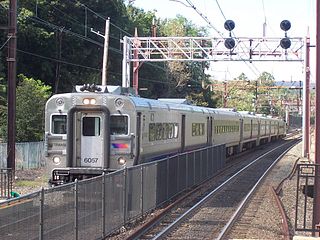
The Comet railcar is a class of locomotive-hauled railcars that was first designed in the late 1960s by Pullman-Standard as a modern commuter car for North American rail lines. Later, the Comet moniker was adopted by NJ Transit for all of its non-powered single level commuter coaches. Additional series of cars bearing the Comet name, based on the original design, have since been built by Bombardier Transportation and Alstom. The successful design was adopted by numerous commuter agencies.

Shoreliners are a class of locomotive-hauled rail car used by the Metro-North Railroad. They are similar to the Comet coaches used by New Jersey Transit. Ownership of the fleet is split between the Metropolitan Transportation Authority (MTA) and the Connecticut Department of Transportation, as part of the latter's operating agreement with the MTA. MTA coaches have blue window bands, while CTDOT coaches have red ones. Many of the Shoreliner cars are named in honor of people and places significant to their service area, such as The Connecticut Yankee and Washington Irving.

A gangway connection is a flexible connector fitted to the end of a railway coach, enabling passengers to move from one coach to another without danger of falling from the train.

The MultiLevel Coach is a bi-level passenger rail car for use on commuter rail lines. Originally built by Bombardier Transportation beginning in 2006, they are now built by Alstom since 2021, who markets the coaches as part of their Adessia Coach series.

The Jersey Arrow is a type of electric multiple unit (EMU) railcar developed for the Pennsylvania Railroad, and used through successive commuter operators in New Jersey, through to NJ Transit. Three models were built, but only the third model is in use today. The series is similar to SEPTA's Silverliner series, but include center doors among other differences in details.

Silverliner is the name given to a series of electric multiple unit (EMU) railcars in commuter rail service in the Philadelphia area since 1958. As of the introduction of the Silverliner V in 2009–2010, there have been 5 generations of Silverliner cars, identified by the Roman numerals I through V placed after the name Silverliner. The Silverliner name came from the classes' shiny stainless steel body shell, which contrasted with the painted and frequently rusting carbon steel railcars used by the Pennsylvania and Reading Railroads between 1915 and 1936. Applied to the first large production order in 1963, the cars made such an impression that the name has since been applied to all subsequent MU classes purchased by SEPTA for the Regional Rail services.

The California Car is the first generation of intercity railcars owned by the California Department of Transportation (Caltrans) and operated by Amtrak under the Amtrak California brand on intercity corridor routes in Northern and Central California. The cars were built in the mid-1990s for the Caltrans Division of Rail by Morrison–Knudsen and the American Passenger Rail Car Company (Amerail). The cars are similar in exterior dimensions to Amtrak's Superliner, but original in design to provide rolling stock suitable for California intercity services up to six hours, with more frequent stops than most other Amtrak routes. All cars were overhauled by Alstom at its Mare Island facility between 2009 and 2012.

On September 29, 2016, an NJ Transit commuter train crashed at Hoboken Terminal in Hoboken, New Jersey. The accident occurred during the morning rush hour, at one of the busiest transportation hubs in the New York metropolitan area. One person died, and 114 others were injured. The train operator, who was in the cab car, was among the injured.
The rolling stock of the Bay Area Rapid Transit (BART) system consists of 782 self-propelled electric multiple units, built in four separate orders.
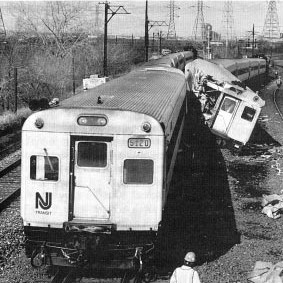
On February 9, 1996, two NJ Transit commuter trains collided at Bergen Junction in Secaucus, New Jersey, United States. This accident occurred during the morning rush hour just south of the current Secaucus Junction station. It is NJ Transit's deadliest accident to date and the first in which passengers and crew died. Three people were killed and 162 injured.





















